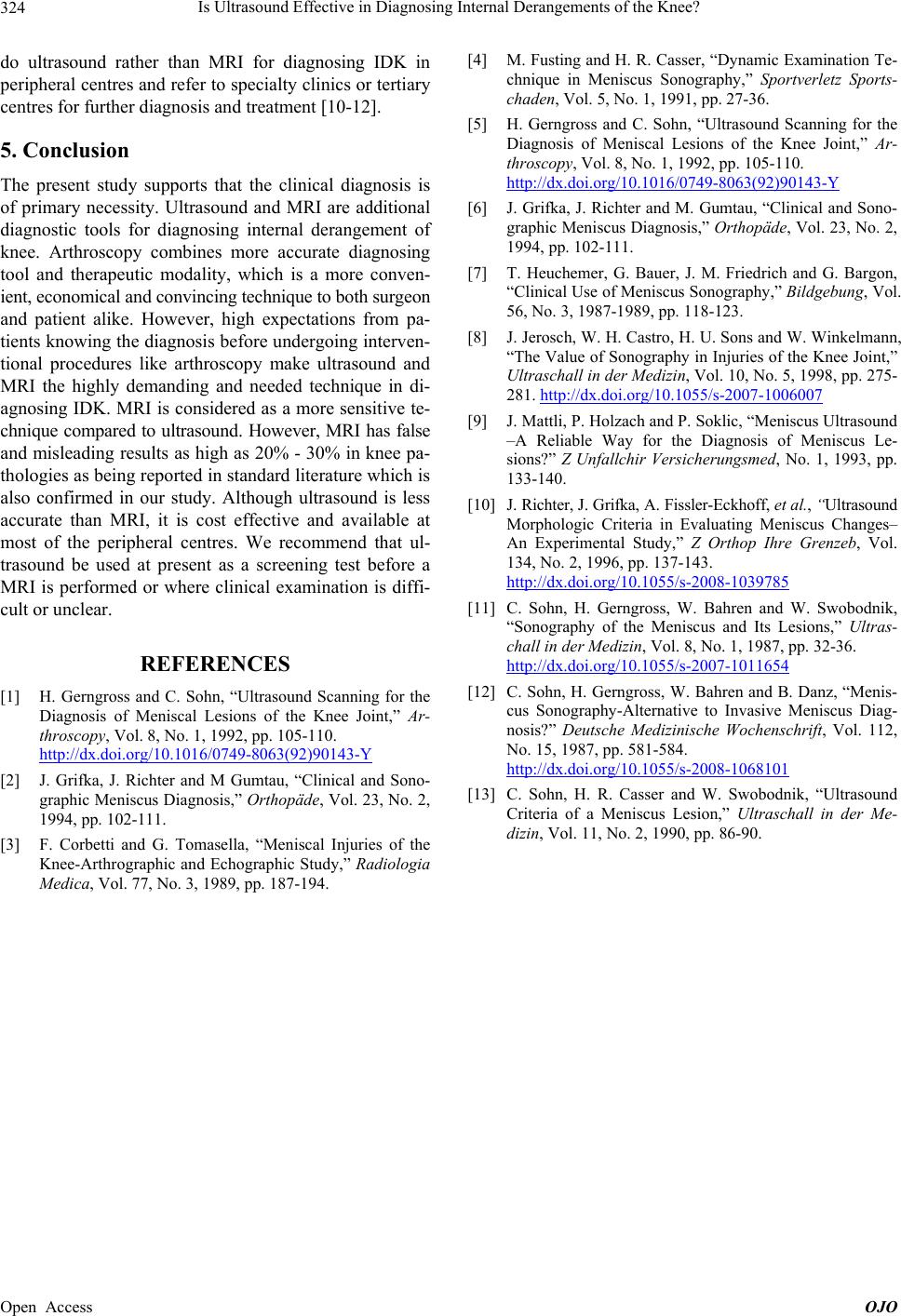
Is Ultrasound Effect iv e in Diagnosing Internal Derangements of the Knee?
324
do ultrasound rather than MRI for diagnosing IDK in
peripheral centres and refer to specialty clinics or tertiary
centres for further diagnosis and treatment [10-12].
5. Conclusion
The present study supports that the clinical diagnosis is
of primary necessity. Ultrasound and MRI are additional
diagnostic tools for diagnosing internal derangement of
knee. Arthroscopy combines more accurate diagnosing
tool and therapeutic modality, which is a more conven-
ient, economical and convinci ng t echnique to both surgeon
and patient alike. However, high expectations from pa-
tients knowing the diagnosis befor e undergoing interven-
tional procedures like arthroscopy make ultrasound and
MRI the highly demanding and needed technique in di-
agnosing IDK. MRI is considered as a more sensitive te-
chnique compared to ultrasound. However, MRI has false
and misleading results as high as 20% - 30% in knee pa-
thologies as being reported in standard literature which is
also confirmed in our study. Although ultrasound is less
accurate than MRI, it is cost effective and available at
most of the peripheral centres. We recommend that ul-
trasound be used at present as a screening test before a
MRI is performed or where clinical examination is diffi-
cult or unclear.
REFERENCES
[1] H. Gerngross and C. Sohn, “Ultrasound Scanning for the
Diagnosis of Meniscal Lesions of the Knee Joint,” Ar-
throscopy, Vol. 8, No. 1, 1992, pp. 105-110.
http://dx.doi.org/10.1016/0749-8063(92)90143-Y
[2] J. Grifka, J. Richter and M Gumtau, “Clinical and Sono-
graphic Meniscus Diagnosis,” Orthopäde, Vol. 23, No. 2,
1994, pp. 102-111.
[3] F. Corbetti and G. Tomasella, “Meniscal Injuries of the
Knee-Arthrographic and Echographic Study,” Radiologia
Medica, Vol. 77, No. 3, 1989, pp. 187-194.
[4] M. Fusting and H. R. Casser, “Dynamic Examination Te-
chnique in Meniscus Sonography,” Sportverletz Sports-
chaden, Vol. 5, No. 1, 1991, pp. 27-36.
[5] H. Gerngross and C. Sohn, “Ultrasound Scanning for the
Diagnosis of Meniscal Lesions of the Knee Joint,” Ar-
throscopy, Vol. 8, No. 1, 1992, pp. 105-110.
http://dx.doi.org/10.1016/0749-8063(92)90143-Y
[6] J. Grifka, J. Richter and M. Gumtau, “Clinical and Sono-
graphic Meniscus Diagnosis,” Orthopäde, Vol. 23, No. 2,
1994, pp. 102-111.
[7] T. Heuchemer, G. Bauer, J. M. Friedrich and G. Bargon,
“Clinical Use of Meniscus Sonography,” Bildgebung, Vol.
56, No. 3, 1987-1989, pp. 118-123.
[8] J. Jerosch, W. H. Castro, H. U. Sons and W. Winkelmann,
“The Value of Sonography in Injuries of the Knee Joint,”
Ultraschall in der Medizin, Vol. 10, No. 5, 1998, pp. 275-
281. http://dx.doi.org/10.1055/s-2007-1006007
[9] J. Mattli, P. Holzach and P. Soklic, “Meniscus Ultrasound
–A Reliable Way for the Diagnosis of Meniscus Le-
sions?” Z Unfallchir Versicherungsmed, No. 1, 1993, pp.
133-140.
[10] J. Richter, J. Grifka, A. Fissler-Eckhoff, et al., “Ultrasound
Morphologic Criteria in Evaluating Meniscus Changes–
An Experimental Study,” Z Orthop Ihre Grenzeb, Vol.
134, No. 2, 1996, pp. 137-143.
http://dx.doi.org/10.1055/s-2008-1039785
[11] C. Sohn, H. Gerngross, W. Bahren and W. Swobodnik,
“Sonography of the Meniscus and Its Lesions,” Ultras-
chall i n der Medizin, Vol. 8, No. 1, 1987, pp. 32-36.
http://dx.doi.org/10.1055/s-2007-1011654
[12] C. Sohn, H. Gerngross, W. Bahren and B. Danz, “Menis-
cus Sonography-Alternative to Invasive Meniscus Diag-
nosis?” Deutsche Medizinische Wochenschrift, Vol. 112,
No. 15, 1987, pp. 581-584.
http://dx.doi.org/10.1055/s-2008-1068101
[13] C. Sohn, H. R. Casser and W. Swobodnik, “Ultrasound
Criteria of a Meniscus Lesion,” Ultraschall in der Me-
dizin, Vol. 11, No. 2, 1990, pp. 86-90.
Open Access OJO